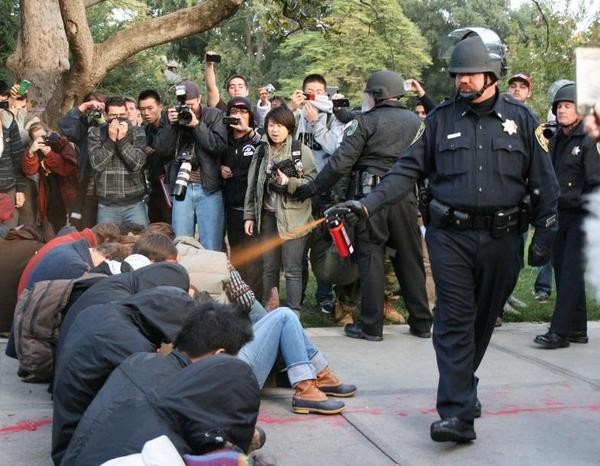Even though police brutality is not something that is new in America, it has only recently received national attention within the last year or so after the emergence of the Ferguson and St. Louis tragedies. According to a statistics report released from the FBI last year, even though violent crime has decreased to its lowest rate in about forty years, police violence against citizens has risen sharply. [ref]John Vibes, “FBI Report: Americans Less Violent than Ever, Except for Police,” The Free Thought Project, November 12, 2014, accessed May 27, 2015, http://thefreethoughtproject.com/prison-statistics/ [/ref] The FBI’s annual Uniform Crime Report revealed that in 2013 alone, 461 felony suspects had been shot by police, which is the highest amount of felon suspects shot in two decades. Coinciding with the rise of police brutality, there has also been an increase, over the years, in police militarization as well. [ref] Mark Thompson, “War Comes Home: The Militarization of U.S. Police Forces,” Time, August 19, 2014, accessed May 27, 2015, http://time.com/3144818/ferguson-police-militarization-pictures/ [/ref] With better equipment and technology, it is becoming more and more difficult to distinguish the police from the military.
The Johnson County Police Department is one of eight police departments in Indiana that is in possession of Mine Resistance Ambush-Protected Vehicles (MRAPs). Indeed, MRAPs are armored vehicles generally designed to withstand heavy blasts and other specialized threats – a feature suited for Iraq or Afghanistan, not for the small streets of Johnson County. [ref] Mark Alesia, “Overkill? Small Town Buys Armored SWAT Vehicle,” USA Today, June 9, 2014, accessed May 27, 2015, http://www.usatoday.com/story/news/nation/2014/06/09/police-military-surplus-purchase-debate/10221551/. [/ref] Across the nation, police departments are receiving drones, tanks, grenade launchers, and other gear, designed for a war zone. [ref] John Whitehead, “Drones, Tanks, and Grenade Launchers: Coming Soon to a Police Department Near You,” The Huffington Post, November 18, 2013, accessed May 27, 2015, http://www.huffingtonpost.com/john-w-whitehead/police-military-equipment_b_4296948.html [/ref] The vendetta is that militarization of the police force encourages a culture of police brutality.
With the ever growing emergence of the American people’s distrust in law enforcement, many police departments are making strides to remedy the situation. The Cleveland police department, for example, recently agreed to adhere to the federal reforms that were set up by the United States Department of Justice. These new rules prohibit officers from using force against people who talk back, or as punishment against those who try to run away. Pistol whipping and fire warning shots are also forbidden by the new reforms. These rules were recently enforced so it is too early to tell what kind of effect these rules will actually have. While these rules are intended to restrain violent behavior from police officers, it might not be enough. Even with these regulations, the police can still violate and deny these rules in the event of a complaint.
In addressing this potential discrepancy, the department is also pushing to have body cameras for all of their police officers by the end of 2015. [ref] “Cleveland Police Department Agrees to Carry out Federal Reforms,” BBC, May 26, 2015, accessed May 27, 2015, http://www.bbc.com/news/world-us-canada-32887033. [/ref] The idea behind body cameras is to record police activity and interactions with the citizens, which in turn, provides accountability on the officers’ part. According to a study conducted by William Farrar, a police chief in Rialto, California, departments that issued body cameras to their officers reduced complaints about excessive force. [ref] Randall Stross, “Wearing a Badge, and a Video Camera,” The New York Times, April 6, 2013, accessed May 27, 2015, http://www.nytimes.com/2013/04/07/business/wearable-video-cameras-for-police-officers.html?_r=2&. [/ref] In fact, Farrar’s study revealed that there were sixty percent less reported incidents of police aggression towards citizen when body cameras were worn. The study also discovered that police departments received eighty-eight percent less complaints since the body cameras were issued. Officers were twice as likely to use force when they turned the body cameras off. While this study provided strong evidence for the benefits of body camera, the statistics might not be representative of the average police in America.
Opponents argue that body cameras are a breach in privacy, especially for citizens who feel uncomfortable with being recorded.[ref] Jessica Glenza, “Body Cameras for Police Officers? Not so Fast, says Researchers,” The Guardian, December 4, 2014, accessed May 31, 2015, http://www.theguardian.com/us-news/2014/dec/04/body-cameras-police-eric-garner. [/ref] There are specific cases that people want to keep private, like domestic violence and rape incidents, which may be open to the public due to the cameras. Since the requirement for body cameras have been recent, there hasn’t been much regulation for the body cameras themselves, which can open the door for police to abuse their cameras. Investing in body cameras can also prove to be an expensive endeavor, with each camera ranging from $200 to $1,000. While there are concerns for privacy from both police and citizens, [ref] Martin Kaste, “Police Departments Issuing Body Cameras Discover Drawbacks,” NPR, January 20, 2015, accessed May 31, 2015, http://www.npr.org/sections/alltechconsidered/2015/01/22/379095338/how-police-body-camera-videos-are-perceived-can-be-complicated. [/ref] body cameras serve to benefit both parties. Ferrer’s study also reported that citizens would often times come into the police station with a complaint. By having a video on file, the police can accurately see if the complaints were valid. If not, the citizen would drop the complaint. Indeed, body cameras provides legal protection for the police whenever there is a false claim made against them, and forces them to be more aware and accountable of their actions when interacting with the citizens.
The need for body cameras can be explained with the Stanford Prison Experiment. Participants were given the role of either a prison guard or a prisoner. [ref] “Stanford Prison Experiment: A Simulation Study of the Psychology of Imprisonment,” accessed May 28, 2015. [/ref] Those who were assigned to become a prison guard abused their power and mistreated the participants who were assigned to be prisoners, despite the fact that it wasn’t a legitimate position of power. The implications of this study suggest that when people, when given a position of power, are likely to abuse it. Continuing to increase the power of the already militarized police force has negative implications. By requiring police officers to wear body cameras it can balance out the power of the police officers and return it back to the American people.
Take Action:
This petition pushes for police in Ferguson and St. Louis County to wear body cameras. This petition, in particular, was created by a Ferguson native who understands the problem of police abusing their power in his town.
Color of Change is and organization that “exists to strengthen Black America’s political voice.” In this particular petition, the group pushes for body cameras to be mandatory for police officers.





